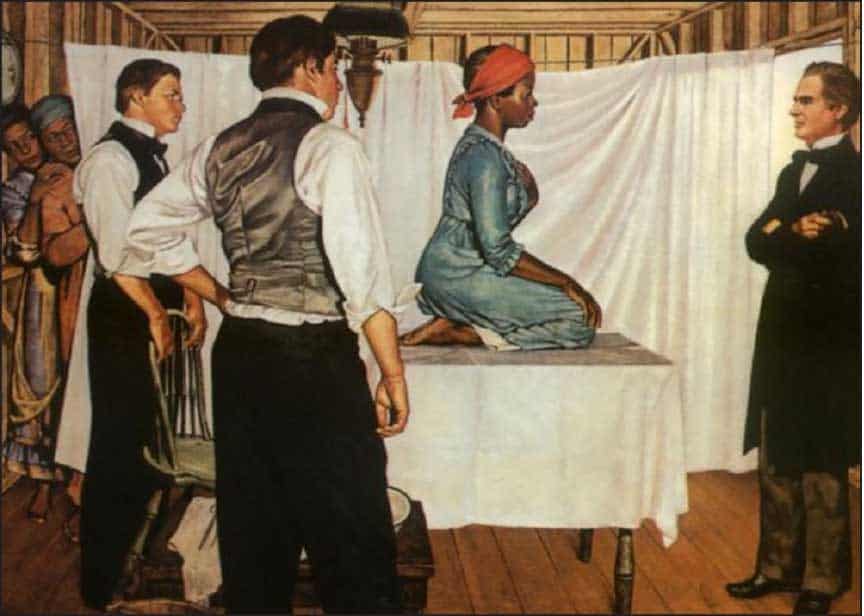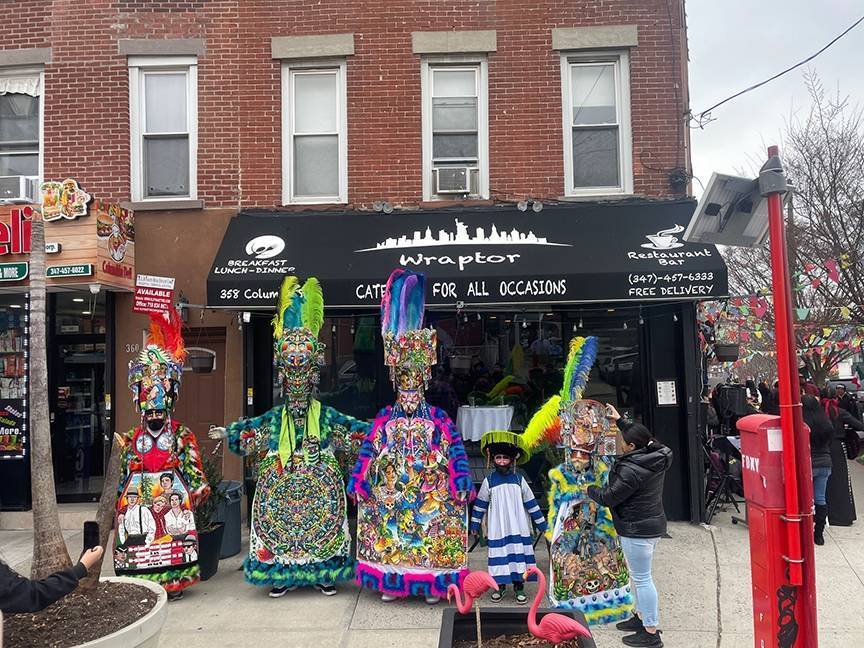
Pioneer Works planned White Man on a Pedestal over 18 months ago, yet its uncanny relevance today seems like a rapid-fire response to the latest headlines. Perhaps we shouldn’t be surprised: artists Doreen Garner and Kenya (Robinson) have tapped into an aspect of US history that has always existed, namely white patriarchy’s force over black female bodies. This is a remarkable collaborative exhibit that pointedly conveys a horrifying and pervasive reality without losing poise or hope for a future that learns from the past.
White Man on a Pedestal is a show that requires your presence; pictures really don’t do justice to Garner’s 18 foot, blood-tinted polyurethane sculpture of J. Marion Sims, a 19th century doctor who’s dubbed “The Father of Gynecology” and experimented on enslaved black women without anesthesia. Garner dissects Sims and the actions that led him to becoming a white man on pedestal. (Sims has three statues in the US, including one on East 103rd Street bordering Central Park).
Garner calls the sculpture “PONEROS,” which is Greek for harmful or evil one. Garner’s monument reconstitutes the memory of a man whose actions (like the system that fostered them) were nefarious. Garner made the blood-red statue from insulation foam and polyurethane. Covered in silicone, she then removed the outer layer to create a “skin” that she placed in a glass coffin lit by halogen lamps. On November 30, Garner will perform the vaginal fistula repair that Sims is best known for on the “corpse” of red skin.
In Garner’s world, Sims receives the treatment he subjected black women to: he’s surgically mutilated without consent; his name is forcibly given; and he’s operated on as if he can feel no pain.
If you wonder what kind of tools Sims used, there’s 15 gynecological tools on loan from Mutter Museum in Philadelphia. The overview shows a Vaginal Speculum, or Sims’ Speculum, so named after its founder. The procedure still helps women with some post-birth issues today, but his methods were racially motivated — even when avoiding presentism, it’s difficult to see how his means were justified.
Sims purchased a girl he logged in his notebook as Anarcha, who was 17 when he started experimenting on her. From 1845 to 1850, he performed over 30 operations on her without any form of anesthesia; Sims gave an anesthetic ether to all of his white patients since 1842. The exhibit pointedly asks why Sims has a statue in
Central Park while there are no memorials to the women he experimented on. According to Sims’ records, their names were Anarcha, Betsey, and Lucy; an increasing number of historians and artists have started to call them “The Mothers of Gynecology.”
One of the more eerie aspects of Garner’s work is a foam leg splayed open on a metal surgery tray. The leg rotates beneath show lights, creating the spectacle of a prized car in a show room.
The piece is a reaction to Harriet Washington’s book, Medical Apartheid (2007). W.H. Robert, Sims’ contemporary, told students that slaves felt less pain and that doctors shouldn’t hesitate to amputate colored patients. Washington examines one incident where Robert amputated the leg of a 15 year old black girl for a relatively minor injury. Washington examines this “hierarchy of amputation” and quotes the good doctor that students should, “Hesitate much less to remove a limb…, if he be slave, than if he be a free man, and especially a white man.”
To this horrifying slice of history, Garner created “A Fifteen Year Old Girl Who Would Never Dance Again; A White Man in Pursuit of the Pedestal.” As the leg rotates, you see jewels in it; It’s grotesque in its beautiful and animalistic impulses. By pairing it in a beautiful setting, Garner questions what cruelty lies beneath the figures we chose to celebrate.
In this reevaluation of Sim’s legacy, the most condemning evidence is “Rack of those Ravaged and Unconsenting.” Steel pins and meat hooks hold up “carcusses” made of insulation foam of those experimented on without consent. The hung body parts are dotted with glass beads and pearls, a hint that though desecrated these bodies haven’t lost their gleam of beauty.
“It’s so repulsive but also beguiling,” curator David Everitt Howe said, “because it’s shimmering, made of pearls and beads.” Like all objects in this exhibit, the piece is nearly beautiful until you travel closer and see what’s always been there.
Kenya (Robinson)
Since 2013, Kenya (Robinson) has kept a white figurine named Dave Fowler in her purse. To help her know the oppressor is with her, Howe said, though you could interpret it as (Robinson) pinching the figure of white supremacy to a tiny, laughable size. The figurine has a suit and briefcase, originally in color but whited out for this piece. He’s corporate mediocrity exposed, but also, as (Robinson) wrote about him in prior exhibits, “A talisman. A reminder of perception and how its power can be manipulated.”
“[The exhibit] began as this idea of meat and bone,” Howe said. “Dave is this fetish object that repeats in material and form throughout the show; he’s here in this terrifying, military-march, terracotta soliders reference.”
While Garner considers historical figures in white supremacy, (Robinson) looks at the imaginary (if it weren’t so palpable) nuances of racism and white supremacy. Garner’s pieces possess a crimson red where (Robinson) paints everything with a milky white.
(Robinson) created an arresting image with Twelve Thousand Maniacs!, a two story wall that features thousands of Dave Fowler figurines marching down it before landing in a giant pool of other Dave Fowler figurines. Pioneer Works printed 12,000 of these five inch figurines. 10,000 line the towering wall in a shout out to the Terracotta Army. As with Garner’s sculptures, the piece looks beautiful from afar, but with each step becomes surreal, freaky, then (like the idea of white supremacy) risible.
At the end of the exhibit, you’ll be surprised to see as altar, replete with plastic beads, gaudy table cloths, and fake flowers. 2,000 other Dave Fowlers entangle together to make a tawdry web of hanging figurines. It feels like a funeral, which is exactly what (Robinson) has in mind; this is an imagined space for the death of white supremacy.
With the piece If I Were King…, (Robinson)’s cheeky vision made a human-sized Dave Fowler out of foam then covered him with astroturf. Lying supine and suspended a good 12 feet from the floor, this particular Dave Fowler appears swallowed by a golf course.
As Howe explained, everything is arranged to celebrate the demise of white supremacy. There’s even a disco ball to celebrate Dave Fowler’s funeral in a performance scheduled for December 17th, after which the thousands of the little Dave Fowler’s will be buried around the city.
Ultimately, White Man on a Pedestal asks what, once the notorious elements of our past are exposed and buried, will we build next?









One Comment
Pingback: – ‘White Man on a Pedestal’